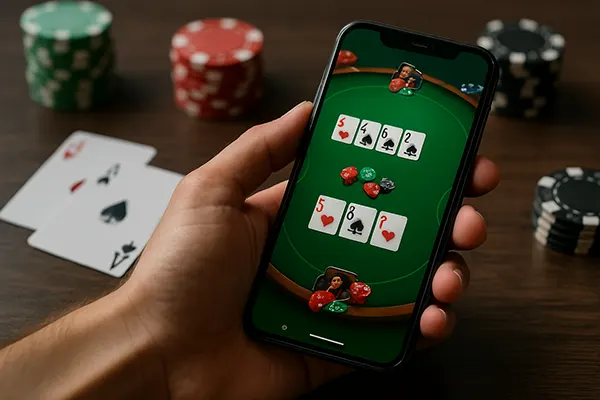Playing on Mobile: How Poker Strategy Evolves on Smartphones

Over the past decade, mobile technology has reshaped not only communication and entertainment but also the world of online gaming. Poker, in particular, has undergone a significant transformation. As more players shift from desktop to mobile platforms, strategies adapt accordingly. February 2025 data shows that over 65% of global poker traffic now comes from smartphones. This change is not just technological—it’s deeply strategic.
Changing Game Dynamics on Small Screens
Smartphone poker play alters the rhythm and perception of the game. Unlike the traditional setup with multi-table desktop displays and large monitors, mobile poker condenses the experience into a compact, touch-responsive interface. Players now make faster decisions due to streamlined navigation and limited visible information, which can lead to either intuitive brilliance or costly mistakes.
The single-table focus of most mobile poker apps impacts multi-tabling strategies. While some modern apps allow up to four simultaneous games, most players opt for one or two, placing greater emphasis on precision and attention to detail. The interface design also limits access to live stats, forcing users to rely more heavily on memory, observation, and simplified HUDs (if available).
Furthermore, mobile gameplay encourages shorter sessions. Whether commuting or taking quick breaks, players often log in for brief bursts of activity. This format favours tight-aggressive styles and value betting over slow, exploitative plays that require longer observation periods. It also increases variance, as short sessions reduce the long-term levelling of poker’s inherent swings.
Strategic Adjustments for Mobile Play
One major shift for mobile users is the minimisation of bluff-heavy tactics. With less time and reduced note-taking capacity, mobile players are less inclined to track opponents’ tendencies in detail. Therefore, straightforward ABC poker becomes more effective. Many top online grinders now recommend prioritising hand value and positional awareness over elaborate deception when playing on phones.
Another adaptation is pre-setting decisions. Many apps offer features like auto-fold, call, or raise settings before it’s a player’s turn. Advanced users pre-select their moves based on board texture and stack sizes, saving precious seconds. This approach, however, requires discipline and careful planning to avoid robotic, exploitable patterns.
Battery life and connectivity also factor into strategic decisions. In high-stakes tournaments or cash games, a sudden disconnection can cost real money. As a result, mobile players tend to choose environments with stable Wi-Fi and avoid fringe spots with potential signal loss. Some even use backup power banks to ensure continuous access during extended play.
The Impact of Touch Interfaces on Reaction and Decision Time
Touchscreen controls differ substantially from mouse-and-keyboard setups. The tactile element introduces both convenience and new types of misclicks. A misplaced thumb or lag in app response can result in unwanted folds or accidental all-ins. Skilled mobile players develop muscle memory and specific gestures to avoid such errors, refining their motions through repetition.
Speed is another key factor. Desktop players benefit from hotkeys and faster input precision. On mobile, even a half-second delay can change the course of a hand. To compensate, players simplify their decision trees. They develop faster heuristic-based play—relying on core principles like position, stack depth, and opponent aggression rather than deeper analysis of ranges or meta-game dynamics.
In heads-up and hyper-turbo formats, where action is rapid-fire, this quick-reactive style thrives. February 2025 reports from major poker rooms such as PokerStars and GGPoker show a steady rise in fast-fold formats among mobile users. These game types suit the limitations of touchscreens while capitalising on the spontaneous nature of mobile use.
Interface-Driven Playstyle Evolution
The influence of mobile design extends into psychological comfort zones. Touching the screen feels different than clicking with a mouse—it can feel more personal, direct, and impulsive. Consequently, players tend to act more intuitively, and less deliberately. This has led to a rise in ‘snap decisions’ and gut plays, especially in recreational mobile users.
Visual clutter is another factor. Mobile poker apps often display fewer details: chip stacks, player stats, bet history. As a result, decisions are based more on visual cues and less on historical data. Game designers now focus on making information glanceable and intuitive, adjusting colour contrasts and animations to subtly guide players’ choices.
This design language creates an environment where instinctive plays dominate. While experienced grinders may still run GTO simulations off-device, mobile play itself leans toward simplified ranges and exploitative adaptations. It’s a shift away from perfectionism and toward situational practicality.

Opportunities and Challenges in Mobile Poker Tournaments
Mobile access has democratised tournament participation. Players can now enter MTTs (multi-table tournaments) from anywhere—on the train, at lunch, or during downtime. In February 2025, major sites reported that nearly 40% of tournament entries were made from mobile devices. This surge creates larger fields, softer competition, and more prize variability.
However, the environment presents challenges as well. With more distractions around and smaller screens, deep focus is hard to maintain. Late-stage tournaments—where every decision matters—become even more mentally taxing on mobile. Many pros suggest switching to tablets or desktops for final tables to reduce physical strain and improve visual accuracy.
That said, mobile qualifiers and satellites have become a go-to for casual grinders. Micro-stake events held hourly attract thousands of entrants, providing a low-risk way to access high-value tourneys. Strategic use of these mobile-first satellites is now a key element in many players’ long-term bankroll management plans.
Future Trends in Smartphone Poker Strategy
As mobile poker continues to grow, we can expect more personalised AI integration. Apps will likely offer real-time feedback, suggesting optimal plays based on user data and historical behaviour. Already, some beta tools like Run It Once Mobile Coach are testing AI-driven coaching overlays.
We’ll also see growth in portrait-mode poker, catering to one-handed play. This design suits on-the-go users and opens up strategy shifts where quick thumb decisions define the tempo. Combined with short-stack formats like Spin & Go or Flipout, mobile poker will become even more fast-paced and adrenaline-driven.
Ultimately, the mobile era of poker isn’t just about convenience—it redefines the game itself. Strategic adjustments will continue as hardware, software, and player habits evolve. Those who embrace these shifts and adapt their play accordingly will find new ways to stay competitive in an increasingly touch-screen-driven game world.



